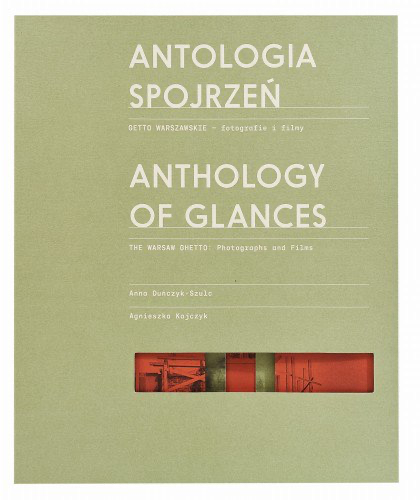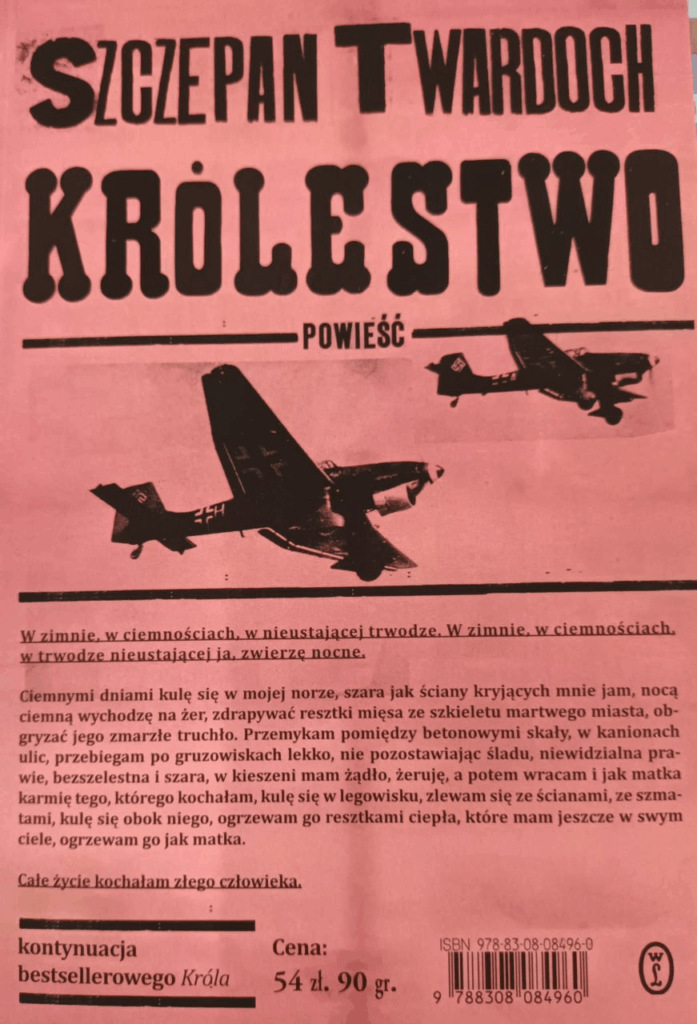Antologia spojrzeń: GETTO WARSZAWSKIE – fotografia i filmy
Anthology of Glances: THE WARSAW GHETTO: Photographs and Films
By Anna Duńczyk-Szulc and Agniezka Kajczyk
Published at the occasion of the 80th anniversary of the Warsaw Ghetto uprising, this book presents nearly 300 photographs and film frames showing what can be called everyday life (and death) in the Ghetto.
Covering the period from 1940 to 1948, the book includes images taken after the complete destruction of the Ghetto and the end of the war, thus also showing the transition from war to its aftermath, from urban environment to a “desert” (Tomasz Szerszeń).
The book is subdivided into four sections: (1) Mapping the Space, (2) From Outside, (3) From Inside and (4) The Post-Ghetto Place, followed by four excellent articles by Anna Duńczyk-Szulc (“An Anthology of Glances”), Agniezka Kajczyk (“The Task of Looking”), Janina Struk (“Conflicts of Viewpoints”) and Tomasz Szerszeń (“In the Desert”).
As Monika Krawczyk, director of the Emanuel Ringelblum Jewish Historical Institute in Warsaw, emphasises in the preface, the images presented in the book “encourage the reader to reflect not only on the tragedy of war, but also on the timeless function of iconography itself in the process of passing on memory to successive generations” (p. 354).
Karolina Ziȩbińska-Lewandowska, director of the Museum of Warsaw, warns in her preface against equating the photographic image with the historical truth, since photographs “can distort reality, change the meaning of things.” We are dealing with “that unspecified space between testimony, evidence, trace, the visible and invisible, truth and untruth, disclosure and concealment, unmasking and feeding the propaganda” (pp. 356–357).
The images also show what Simon Dell, in a different context, calls “the everyday overturned.”¹ These photographs should not be mistaken for neutral documents; most of them have a purpose, constructing Ghetto reality rather than merely documenting it.
This is true especially of the photographs taken by German imagemakers – “Nazi propaganda teams and soldier-tourists” (Struk, p. 400) alike. These imagemakers “are within the walls, but their perspective, unlike that of the victims of this great prison, is not an inside one” (Duńczyk-Szulc, p. 368).
It may be tempting to refer to some of these photographs (especially those without obvious propaganda function and those without obvious depictions of physical violence) in terms of everyday peace. After all, they show the continuation of everyday life in times of violent conflict, “a series of actions and modes of thinking that people utilise to navigate through life in deeply divided and conflict-affected societies.”²
However, Kajczyk emphasizes that the visual construction of “normality” was a regular ingredient of Nazi propaganda material: “everything seemed normal, ordinary – but these were only appearances” (p. 384).
Ordinary people – especially young people³ – may have found, for a limited period of time, ways to navigate their lives even in such extraordinary circumstances. The use of the term peace, however, feels wrong considering both the violence visited upon the population of Warsaw during the German occupation and, in particular, the ghettoisation, deportation and extermination of the Jewish population. Indeed, the book includes many unbearable images, in light of which the use of the term peace would seem cynical.
Yet, as Roger Mac Ginty notes, “Even within the context of apparently all-out war, there may be spaces for initiative, dissent, resistance, and forms of peace”⁴ such as those captured in amateur film frames showing “the Jewish community in action, taking risks” (Kajczyk, p. 388).
Duńczyk-Szulc describes a woman shown in one of the pictures taken at the much-photographed intersection of Chłodna and Żelazna Streets who apparently “behaves ‘normally,’ even if the place is anything but normal” (p. 363) thus refusing, perhaps, to succumb to the logic of the abnormal or acknowledging that Ghetto life has become normal.
Is this a visual representation of an act of resistance and, if so, resistance to what – the overall conditions or the presence of a photographer (who, in Duńczyk-Szulc’s description, can aptly be likened to a voyeur) or both or something else entirely?
There is no way of knowing – what seems to indicate closeness may reference distance; what appears to be an innocent picture may turn out to be the opposite; photographs seemingly taken outside the ghetto may in fact have been taken inside the ghetto walls.
As this remarkable book suggests, this lack of knowledge invites reflection on “Jewish everyday life under occupation” (Duńczyk-Szulc, p. 364). Confronted with “the task of looking” (Kajczyk), it also asks us to understand “looking as a way of practicing historical reflection” (Szerszeń, p. 409).
Furthermore, it alerts us to both the limits of photography’s documentary potentialities and the awkwardness of everyday peace as a concept, its appropriateness in some conditions and its unsuitability in others.
Ngũgĩ wa Thiong’o reminds us of “the intricate web of the mundane and the dramatic, the surreal normality of ordinary living under extraordinary times in a country at war,” the coexistence of “fact and rumour, certainty and doubt, despair and hope, … the real and the surreal.”⁵
Perhaps it is hopelessly naïve to think that this intricate web can be captured by means of photography or the tools academic research offers us.

Warsaw 2023: Museum Warszawy
ISBN 978-83-964731-9-6
416pp
https://sklep.muzeumwarszawy.pl/pl/p/Antologia-spojrzen.-Getto-warszawskie-fotografie-i-filmy/2440
Useful links:
Muzeum Warszawy (Warsaw Museum)
Żydowski Instytut Historyczny im. Emanuel Ringelbluma (Jewish Historical Institute)
Muzeum Historii Żydów Polskich POLIN (Museum of the History of Polish Jews)
Coda
A particularly rewarding inter-textual experience, we would like to suggest, is studying the images shown in this book while reading, at the same time, Szczepan Twardoch’s novel, Królestwo (Kingdom).
In this novel, the reader will find haunting descriptions of many aspects of life and death in the Warsaw Ghetto that can also be seen, or visualized, in the photographs, for example, the complex relationship between inside and outside the ghetto, shifting boundaries, the occasional permeability of the borders, the conditions on the Umschlagplatz. (Regard, for example, images 47 and 48 and visualize Twardoch’s description of David, Hela and Lejb’s passage through the Law Courts building connecting one world to another; pp. 373–374 of the German translation, Das schwarze Königreich.)
In addition to the captions and the essays included in Anthology of Glances, such a parallel reading experience testifies to the power of what Peter Gilgen calls an “intellectual stereoscopic effect” where texts and images support each other in a compelling, irresistible manner.⁶ But even in such cases, we should carefully avoid equating, without further reflection, the resulting image–text composite with the historical truth.

Kraków: Wydawnictwo Literackie, 2018
References
¹ Simon Dell, “Mediation and Immediacy: The Press, the Popular Front in France, and the Spanish Civil War,” in The Mexican Suitcase: The Rediscovered Spanish Civil War Negatives of Capa, Chim, and Taro – Vol 1: The History, edited by Cynthia Young. Göttingen/New York: Steidl/International Center of Photography 2010, p. 46.
² Roger Mac Ginty, Everyday Peace: How So-called Ordinary People Can Disrupt Violent Conflict. Oxford: Oxford University Press 2021, p. 8.
³ Markus Roth and Andrea Löw, Das Warschauer Getto: Alltag und Widerstand im Angesicht der Vernichtung. Munich: C.H. Beck 2013, p. 142.
⁴ Mac Ginty, Everyday Peace, p. 106.
⁵ Ngũgĩ wa Thiong’o, Dreams in a Time of War: A Childhood Memoir. London: Vintage Books 2011, p. 195.
⁶ Peter Gilgen, “Film after History,” in Mapping Benjamin: The Work of Art in the Digital Age, edited by Hans Ulrich Gumbrecht and Michael Marrinan. Stanford: Stanford University Press 2003, p. 56.
